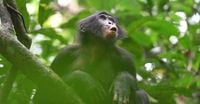In a groundbreaking study published on April 3, 2025, in the journal Science, researchers have found that bonobos, our closest living relatives, exhibit a form of communication that includes a hallmark of human language: compositionality. This ability allows them to combine calls in ways that create new meanings, suggesting that the roots of language may extend far deeper into our evolutionary past than previously thought.
The study, led by postdoctoral researcher Mélissa Berthet at the University of Zurich, involved extensive fieldwork in the Kokolopori Bonobo Reserve in the Democratic Republic of the Congo. Over five months, Berthet recorded 700 bonobo calls, meticulously categorizing them into types such as "peeps," "whistles," "grunts," and "yelps." In total, the researchers documented 567 single calls and 425 pairs, while also noting the contextual details surrounding each call, such as the social interactions and behaviors of the bonobos at the time.
Compositionality, a concept that refers to the ability to combine elements to create complex meanings, has long been considered a unique feature of human language. Linguists categorize compositionality into two types: trivial and nontrivial. Trivial compositionality involves combining words that each have specific meanings to create a fuller picture, while nontrivial compositionality involves more complex interactions where certain parts modify others. For example, the phrase "pumpkin pie" conveys a new idea that is not simply a combination of the two individual words.
According to Simon Townsend, a co-senior author of the study and a comparative psychologist at the University of Zurich, the bonobos demonstrated nontrivial compositionality. He noted that while this ability is orders of magnitude less complex than human language, it represents "another layer chipped away" from the perceived uniqueness of human communication. "That’s what we've evolved it for—to add this important nuance and complexity to the meaning that we convey," Townsend explained.
The findings suggest that the last common ancestor between humans and bonobos, which lived approximately seven million years ago, may have possessed similar communicative abilities. Federica Amici, a primatologist at the University of Leipzig, emphasized that these results push back the timeline of language evolution significantly, indicating that the differences between humans and other primates are not as stark as previously believed.
However, not all experts are convinced. Johan Bolhuis, a neurobiologist at Utrecht University, expressed skepticism about the implications of the study. He argued that the research does not provide significant insights into the evolution of language, stating, "The present findings don’t tell us anything about the evolution of language." Bolhuis raised concerns about whether the bonobos' calls could truly be classified as compositional, as he believes that true compositionality involves following syntactic rules to form larger units of meaning.
In the study, Berthet and her colleagues identified four specific pairs of calls that showed compositionality. One notable combination involved a high hoot and a low hoot. Together, these calls seemed to express a plea for help, potentially signaling distress to distant bonobos during an attack. Berthet explained, "It would be like, ‘Pay attention to me because I am in distress.’”
Another combination, termed a "peep-whistle," emerged in sensitive social situations, such as dominance displays or mating interactions. This indicates that bonobos might use these call combinations to navigate complex social dynamics.
To analyze the calls, the researchers plotted them on a five-dimensional "map" of meaning, allowing them to visualize the relationships between different sounds. This innovative approach, borrowed from linguistic analysis, helped establish a kind of dictionary for the bonobos' vocalizations, revealing that all seven common call types appeared in at least one combination.
Despite the promising results, some experts caution against jumping to conclusions. Shane Steinert-Threlkeld, a computational linguist at the University of Washington, suggested that the nontrivial combined calls might be more akin to idioms than to true compositional structures. He pointed out that the meanings of these combinations may not directly derive from their individual components, further complicating the interpretation of bonobo communication.
Thom Scott-Phillips, a cognitive scientist at Central European University, raised additional questions about the study's findings, noting that even bacteria demonstrate forms of communication that could meet the criteria for nontrivial compositionality. He suggested that the criteria used in this study might not be exclusive to bonobos or even primates.
As researchers continue to explore the depths of animal communication, the study of bonobos opens new avenues for understanding the evolution of language. While the findings indicate that these apes possess a level of compositionality previously thought unique to humans, the debate continues about the extent and implications of these abilities.
Moving forward, Townsend and his team hope to apply their observational methods to other species to investigate the presence of nontrivial compositionality across the animal kingdom. "We don’t know yet if bonobos are special," Berthet remarked. "We developed this method, we used it on bonobos, and we found very cool results. But maybe you could do that on other animals." The ongoing research promises to shed light on the intricate web of communication that connects humans and our primate relatives, revealing the evolutionary threads that bind us together.





